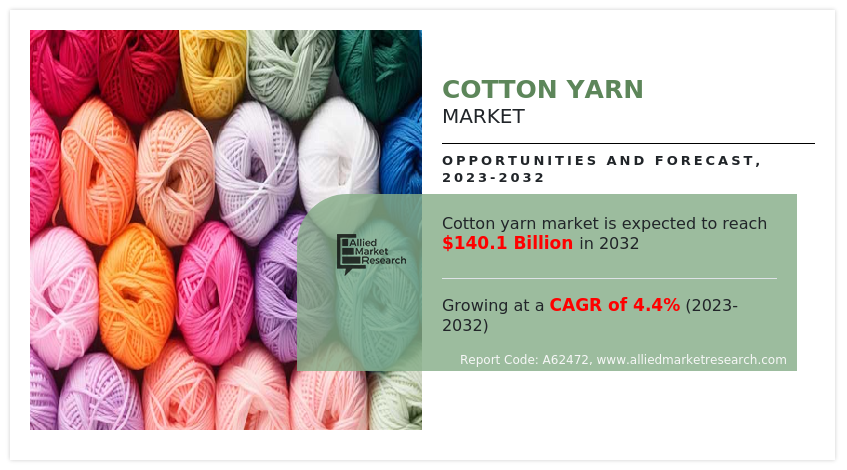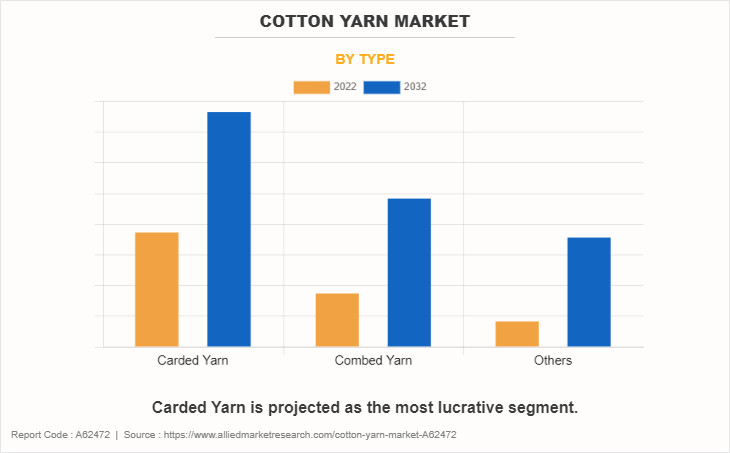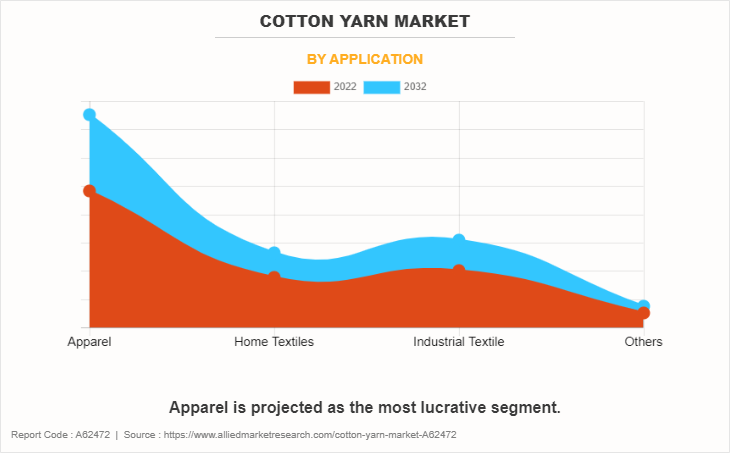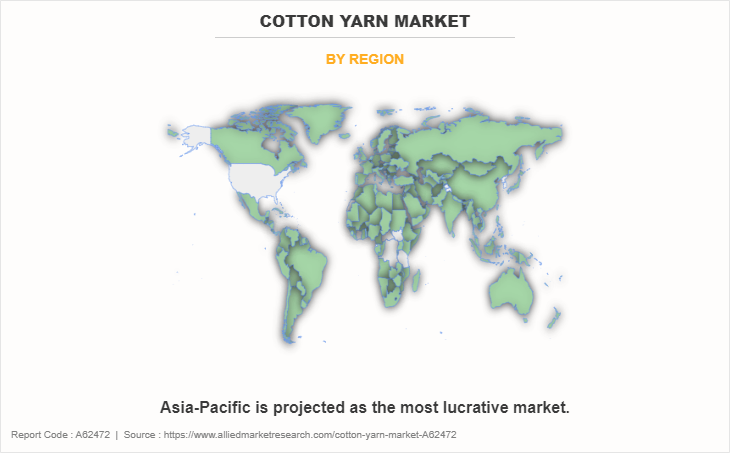Cotton Yarn Market Research, 2032
The global cotton yarn market was size valued at $91.4 billion in 2022, and is projected to reach $140.1 billion by 2032, growing at a CAGR of 4.4% from 2023 to 2032.The cotton yarn market growth is primarily driven by the increase in demand for sustainable and eco-friendly textiles, as consumers shift toward natural fibers. The growth of the global textile industry, particularly in emerging economies, fuels demand for cotton yarn in apparel and home textiles. In addition, advancements in spinning technology enhance production efficiency and quality, attracting manufacturers. The growth of online retail platforms facilitates easier access to cotton yarn products, further propelling market expansion.

Introduction
Cotton fibers are used to produce cotton yarn, a particular form of yarn. It is a popular choice for apparel production as it is a soft, breathable, natural plant-based fiber when it comes to knitting, crocheting, and other textile crafts. It is gentle to the skin, making it an ideal choice for anybody with sensitive skin or allergies. In addition, cotton yarn has great moisture absorption and draining properties that efficiently remove sweat from the body while keeping the wearer dry and comfortable, particularly in hot and humid climates.
Report Key Highlighters:
- Quantitative information mentioned in the global cotton yarn market includes the market numbers in terms of value (USD Million) with respect to different segments, pricing analysis, annual growth rate, CAGR (2023-32), and growth analysis.
- The analysis in the report is provided based on type and application. The study will also contain qualitative information such as the market dynamics (drivers, restraints, opportunities), Porter's Five Force Analysis, key regulations across the region, and value chain analysis.
- A few companies, including Ambika Cotton Mills Limited, Aarti International, Maharaja Shree Umaid Mills Limited, Nahar Spinning Mills Limited, Nishat Mills Limited, Nitin Spinners Limited, Texhong International Group Limited, Trident Limited, India, Vardhman Textiles Ltd., and Weiqiao Textile Co., Ltd., hold a large proportion of the cotton yarn market.
- This report makes it easier for existing market players and new entrants to the cotton yarn business to plan their strategies and understand the dynamics of the industry, which ultimately helps them make better decisions.
Market Dynamics
The extensive use of cotton yarn market growth in textile and apparel production drives. Globalization, changing lifestyles, population growth, fashion trends, and technological advances contribute to rise in demand for apparel and textiles. Cotton yarn is widely utilized in the textile industry. Its natural origin as fibers from the cotton plant is one of the primary variables. It is a desirable option as it is a natural fiber with many advantages. In addition, cotton yarn is environmentally favorable as compared to synthetic fibers as it is renewable and biodegradable considering sustainability. Sustainable and environmentally friendly textiles are becoming more popular as consumers become more aware of how their decisions affect the environment.
Many manufacturers are providing clothing options that are made from cotton yarn and are sustainable. For instance, H&M, a global fashion retailer known for its trendy and affordable clothing, offers a wide range of garments made from cotton yarn, catering to several styles and demographics. Cotton yarn is simple to combine with other fibers to enhance specific characteristics.
For instance, combining cotton with synthetic fibers such as polyester might result in a fabric that offers cotton's softness as well as additional durability and wrinkle resistance. It easily takes colors, providing an enormous amount of color options. This enables designers to quickly produce colorful and appealing apparel designs. Owing to these factors, the cotton yarn market is anticipated to have considerable growth during the forecast period.
The advancements in the manufacturing of cotton yarn are expected to boost the growth of the market during the forecast period. The textile business has changed, owing to technological developments in cotton yarn production, which have enhanced productivity, sustainability, and innovation. The production of cotton yarn is expected to change significantly due to innovations such as automated spinning machines, computerized control systems, 3D printing, and others. Modern automated spinning machines have drastically boosted production speeds while maintaining constant quality, as compared to traditional manual spinning methods that required a lot of labor and time. These machines can handle massive amounts of raw cotton while producing finer and more consistent yarns to meet the demands of the quick-moving fashion industry.
In addition, development of computerized control systems has made it possible to precisely monitor and manage many factors while spinning. Less material waste and excellent yarn quality promote cost effectiveness and sustainability. Sensors and data analytics have reduced production flaws and downtime by improving fault identification and enabling real-time corrections. 3D printing has started to emerge in the manufacture of cotton yarn. It enables designers to experiment with new textures and patterns by permitting the production of complex and unique yarn structures. Innovative textile designs that are individualized and are one-of-a-kind are now possible. Owing to these factors, the cotton yarn market for cotton yarn is expanding as of advancements in technology.
The market expansion for cotton yarn is expected to be severely hampered by the presence of alternatives. Cotton yarn faces competition from a variety of synthetic and artificial substitutes, including polyester, nylon, acrylic, and rayon, despite being a natural fiber. These alternatives to cotton have some benefits that can affect consumer preferences and market demand. Cost-effectiveness is a key factor that influences consumer choices for synthetic alternatives. As synthetic fibers are frequently more affordable to produce, price-conscious customers or enterprises may find them more appealing. Manufacturers may choose synthetic alternatives to save costs and retain profit margins during economic downturns or periods of changing cotton prices.
In addition, alternatives can exceed cotton yarn in terms of durability and performance qualities. Polyester is one example of a synthetic fiber that outperforms cotton in terms of strength, wrinkle resistance, and color retention, making them suitable for clothing that need minimal care and last a long time, such sportswear and activewear. Availability of alternatives hampers the growth of the cotton yarn market.
Rise in sustainable clothing is an excellent growth opportunity for the cotton yarn market. Demand for sustainable clothes has increased, reflecting a shift in consumer ideals that focus on social responsibility, environmental protection, and responsible consumption. As cotton is a natural and biodegradable fiber, it can naturally degrade at the end of its life cycle without harming the environment. Synthetic fibers, on the other hand when degrade, release microplastic contamination. By using cotton yarn to make garments, less non-biodegradable trash ends up in landfills and the ocean, making waste management more sustainable.
In addition, cotton is a renewable resource as it is produced annually through agricultural methods. Sustainable cotton farming methods emphasize conserving water, using fewer chemical pesticides and fertilizers, and encouraging crop rotation to preserve the health of the soil. These procedures are encouraged by groups such as the Better Cotton Initiative (BCI) and organic cotton certifications, making cotton yarn from sustainable sources an eco-friendly option. Thus, rise in demand for sustainable clothes offers growth opportunity for the cotton yarn market.
Segments Overview
The cotton yarn market is segmented on the basis of type, application, and region. On the basis of type, the market is classified into carded yarn, combed yarn, and others. By application, the market is segregated into apparel, home textiles, industrial textiles, and others. Region-wise, the market is analyzed across North America, Europe, Asia-Pacific, and LAMEA.

Cotton Yarn Market By Type
The carded yarn segment held the largest market share in 2022. Home textiles such as blankets, wraps, and pillows are frequently crafted using carded yarn. Artisans and crafters occasionally employ it to handcraft tapestries, wall hangings, and decorative items, leveraging its distinctive texture to enhance the visual appeal of these projects. Furthermore, carded yarn contributes to the creation of children's clothing, shoes, and toys, enhancing their playful and comfortable appeal. These factors are anticipated to drive a significant increase in the demand for carded yarn during the forecast period.

Cotton Yarn Market Application
The apparel segment held the largest market share in 2022. The demand for apparel is rising due to several factors including population growth, changing fashion trends, proliferation of online shopping and e-commerce platforms, and a shift towards sustainable and ethically produced clothing. Cotton yarn plays a significant role in the apparel industry due to its inherent qualities and versatility. Cotton, a natural fiber, is commonly used in clothing as it is permeable, absorbs moisture, and offers comfort.

Cotton Yarn Market By Region
The market is categorized into North America, Europe, Asia-Pacific, and LAMEA. The Asia-Pacific region is one of the fastest-growing regions in the world. Several trends are shaping the landscape of cotton yarn utilization in the Asia-Pacific region. The advent of e-commerce and digital platforms has revolutionized the retail sector, fostering rapid fashion cycles and necessitating versatile materials such as cotton yarn that can adapt to changing trends.
Furthermore, the growing acceptance of ethical and sustainable fashion practices is encouraging producers and customers to choose cotton yarn for its all-natural composition and ethical production. This trend resonates with the region's growing awareness of social and environmental issues.
Competitive Analysis
The key players operating in the global cotton yarn market are Ambika Cotton Mills Limited, Aarti International, Maharaja Shree Umaid Mills Limited, Nahar Spinning Mills Limited, Nishat Mills Limited, Nitin Spinners Limited, Texhong International Group Limited, Trident Limited, India, Vardhman Textiles Ltd., and Weiqiao Textile Co., Ltd. These players have adopted agreement as their key strategy to increase their cotton yarn market shares.
Industry Trends:
The cotton yarn market has experienced several significant trends, driven by evolving consumer preferences, technological advancements, and government initiatives aimed at bolstering the textile sector. According to the Ministry of Textiles, India, the cotton yarn production reached approximately 4.5 million tons in the fiscal year 2022-2023, reflecting a robust recovery from the pandemic disruptions. The demand for sustainable and organic cotton yarn is on the rise, as consumers increasingly prioritize eco-friendly and ethically sourced products. This trend is supported by government schemes promoting organic farming and sustainable practices in the textile industry, such as the Pradhan Mantri Kisan Samman Nidhi (PM-KISAN) scheme, which aims to enhance farmers' income.
Technological advancements in spinning and weaving processes shape the cotton yarn market. Innovations such as air-jet spinning and compact spinning enhance productivity and reduce waste, leading to more efficient production methods. The government has encouraged such advancements through initiatives such as the Production Linked Incentive (PLI) scheme, which incentivizes companies to adopt modern technologies. This investment in technology not only boosts production but also enhances the quality of cotton yarn, catering to the demands of high-end fashion and technical textiles.
Moreover, the export potential of cotton yarn remains strong, with the government actively promoting trade agreements and collaborations to expand market access. As per the latest data from the Directorate General of Commercial Intelligence and Statistics (DGCI&S), cotton yarn exports from India surged to approximately $1.2 billion in the last fiscal year, supported by favorable trade relations with key markets such as the U.S. and Bangladesh. This trend underscores the importance of the cotton yarn sector in India's overall textile export strategy.
Furthermore, the increase in focus on digitalization within the textile industry is another noteworthy trend. The government promotes the adoption of digital technologies through initiatives like the Digital India program, facilitating better supply chain management and enhancing market reach for cotton yarn producers. As manufacturers embrace e-commerce and digital platforms, they are better positioned to meet changing consumer demands and global market trends, ensuring sustainable growth in the cotton yarn sector.
Key Benefits For Stakeholders
- This report provides a quantitative analysis of the market segments, current trends, estimations, and dynamics of the cotton yarn market analysis from 2022 to 2032 to identify the prevailing cotton yarn market opportunities.
- The market research is offered along with information related to key drivers, restraints, and opportunities.
- Porter's five forces analysis highlights the potency of buyers and suppliers to enable stakeholders make profit-oriented business decisions and strengthen their supplier-buyer network.
- In-depth analysis of the cotton yarn market segmentation assists to determine the prevailing market opportunities.
- Major countries in each region are mapped according to their revenue contribution to the global market.
- Market player positioning facilitates benchmarking and provides a clear understanding of the present position of the market players.
- The report includes the analysis of the regional as well as global cotton yarn market trends, key players, market segments, application areas, and market growth strategies.
Cotton Yarn Market Report Highlights
| Aspects | Details |
| Market Size By 2032 | USD 140.1 billion |
| Growth Rate | CAGR of 4.4% |
| Forecast period | 2022 - 2032 |
| Report Pages | 250 |
| By Type |
|
| By Application |
|
| By Region |
|
| Key Market Players | Nishat Mills Limited , Nitin Spinners Limited, Vardhman Textiles Ltd., Trident Limited, India, Weiqiao Textile Co., Ltd., Aarti International, Texhong International Group Limited , Maharaja Shree Umaid Mills Limited, Nahar Spinning Mills Ltd., Ambika Cotton Mills Limited |
Analyst Review
According to the opinions of various CXOs of leading companies, cotton yarn, a specific type of yarn, is made from cotton fibers. It is an ideal material for knitting, crocheting, and other textile crafts as it is a soft, breathable, natural plant-based fiber. Due to its comfort, softness, and breathability, it is favored for normal apparel and a variety of textile products.
The wide usage of cotton yarn in the textile industry and apparel production drives the market growth. It is a preferred material for regular apparel and a variety of textile products due to its comfort, softness, and breathability. Cotton yarn is offered in a variety of thicknesses and grades, allowing a wide range of fabrics and clothing to be produced. In addition, development of technological advances in the manufacturing of cotton yarn also stimulates the growth of the market. However, availability of substitutes such as synthetic fibers hampers the market growth. These cotton substitutes offer some advantages that may influence consumer choices and market demand. A major component influencing customer decisions about synthetic substitutes is cost-effectiveness. Rise in demand for sustainable and eco-friendly clothing seems a great growth opportunity for the cotton yarn market. Cotton yarn is crucial to produce sustainable clothing, owing to its inherent properties and the sustainable farming and production practices utilized in its manufacturing.
The rise of fast fashion continued to influence the cotton yarn market. Manufacturers were adapting to shorter product lifecycles and quicker production turnarounds to meet consumer demand for trendy and quickly changing clothing styles.
Apparel application are the potential customers of cotton yarn market industry.
Asia-Pacific region will provide more business opportunities for cotton yarn market in coming years.
The market players are adopting various growth strategies and also investing in R&D extensively to develop technically advanced unique products which are expected to drive the market size.
Ambika Cotton Mills Limited, Aarti International, Maharaja Shree Umaid Mills Limited, Nahar Spinning Mills Limited, Nishat Mills Limited, Nitin Spinners Limited, Texhong International Group Limited, Trident Limited, India, Vardhman Textiles Ltd., and Weiqiao Textile Co., Ltd are the top players in cotton yarn market.
Loading Table Of Content...
Loading Research Methodology...


